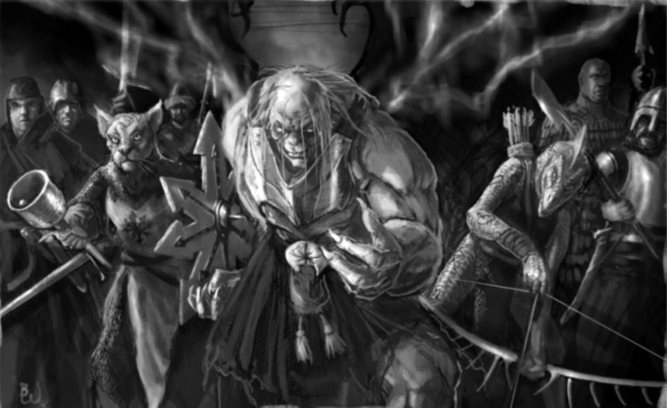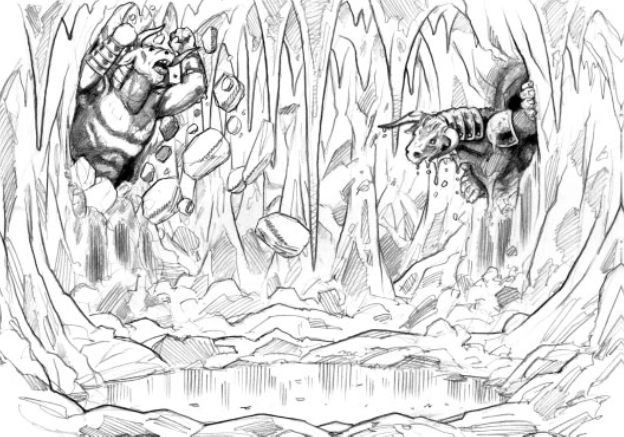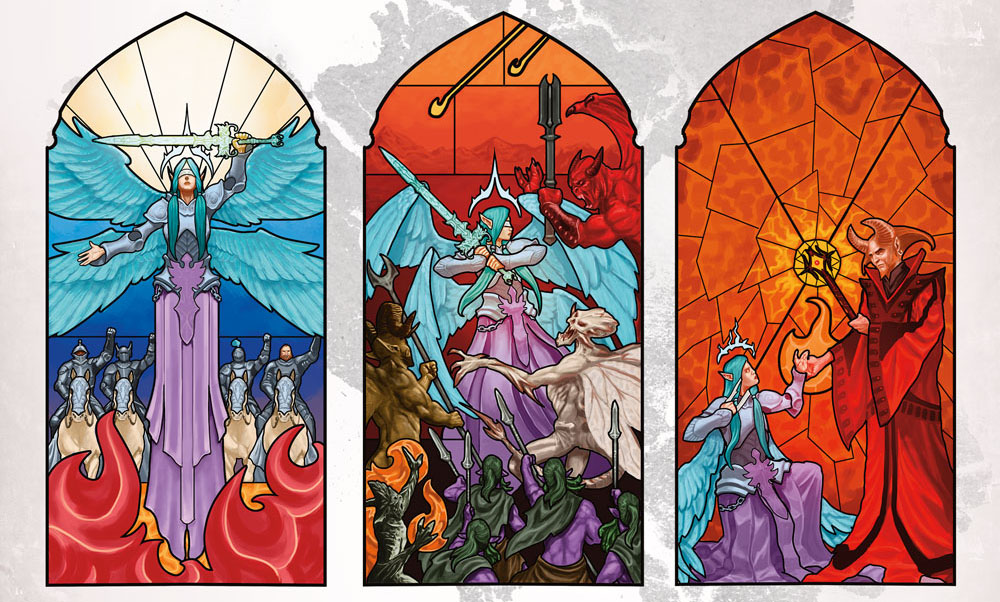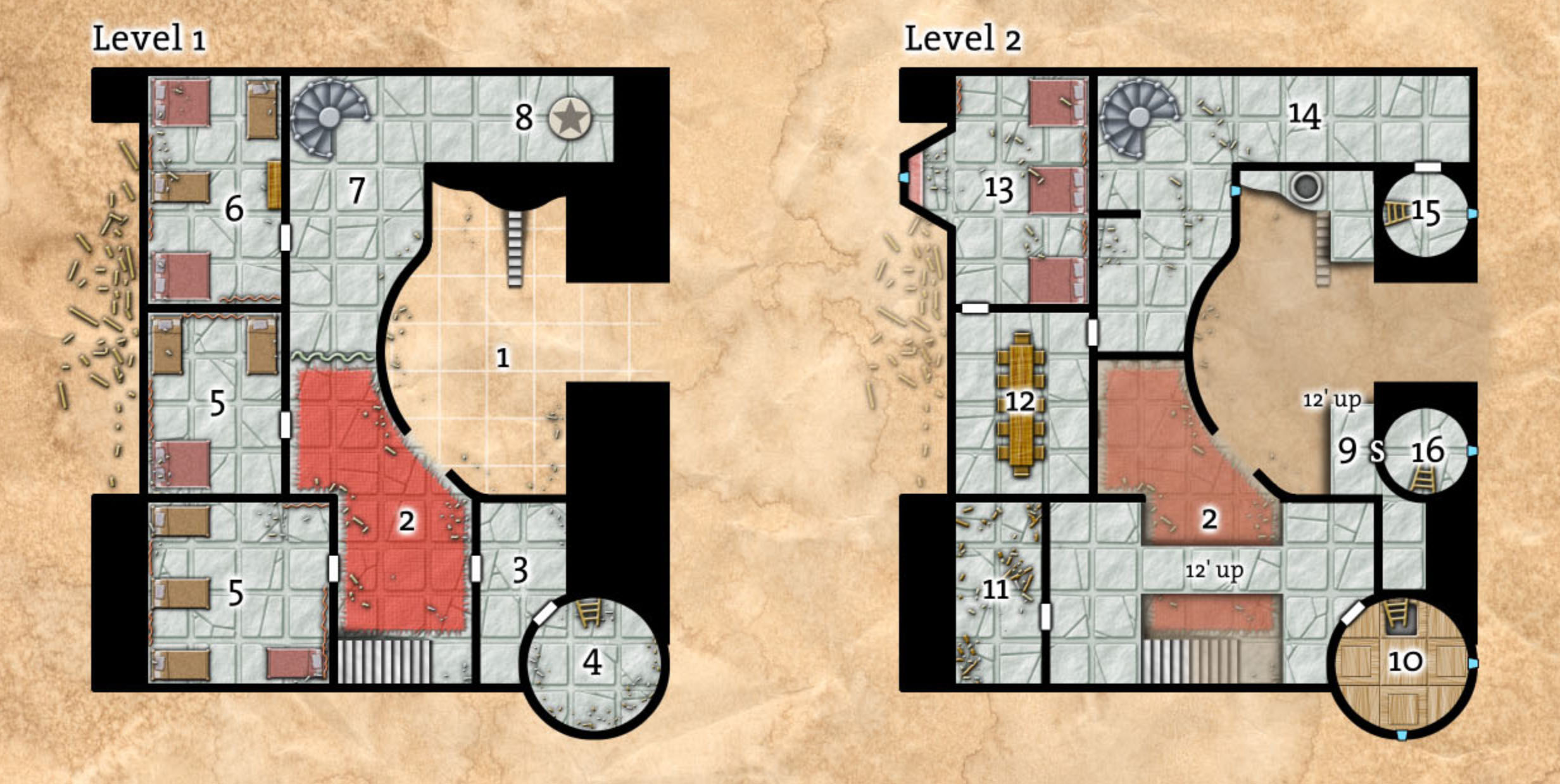
SESSION 23D: THE CHAOS CULTISTS
June 7th, 2008
The 10th Day of Kadal in the 790th Year of the Seyrunian Dynasty
… and found their way blocked by more than a dozen sinister men and women.
At their head was a massive, humanoid creature with wings of darkness and shadow that crackled with blue arcs of lightning. His flesh was a sallow yellow-green, and his long, grey-white hair seemed to be coming out in clumps. His drooping eyes glowed with a white malevolence, and his muscles seemed to bulge unnaturally beneath his skin. Strapped about his broad chest was a silvery breastplate.
Behind him, flanking him to either side, were a litorian and an adrak: The litorian had familiar symbols of chaos shaved into her fur and burned into her skin. The adrak, likewise, had symbols burned or branded onto its scales.
And behind them was a rabble of another half dozen thugs.
The sallow-skinned leader chuckled darkly as they halted in their tracks. “Give me the weapons of chaos and you can leave here with your lives.”
“We don’t have them,” Tee said.
“Don’t lie to me child,” the creature said. “Or you will die.”
“We don’t have them!” Elestra cried. “We didn’t get them yet!”
The litorian waved her hand and a beam of light swept over them. She scowled. “They’re telling the truth, Wuntad.”
Wuntad turned to her. “You’re sure?”
The litorian nodded.
Wuntad turned back to Tee. “Very well. Then you’ll go and get them and then bring them back to me.”
“We can’t do that right now,” Tee said.
“You will do it or you’ll die.”
“It’s not that we won’t, we can’t. We need to rest first, and then—“
With a bellowing roar, Agnarr charged. He caught Wuntad by surprise, but his sword caught on the cultist’s breastplate. With an answering roar of rage, Wuntad swung a muscular claw at Agnarr’s head. The barbarian laughed. “You don’t look much like your picture!”
The other cultists, after stepping back in shock at the suddenness of the assault, were recovering and drawing their weapons.
But they were too slow for Ranthir, who was already completing the casting of a spell: A thick, bulbous sphere of viscous web exploded in the midst of the cultists. It entangled them thoroughly and suspended itself between the wall of the keep and the ground.
Unfortunately, the web blocked their own path of escape. Fortunately, the torch Tor had carried during their explorations through and beneath the keep was still burning. He darted off to one side and began burning a path through the web.
Agnarr had also been caught in the web and he began tearing himself free. But Wuntad was the faster, his wings of lightning-lit darkness tearing through the webs like razor blades and – with a single, powerful beat – propelling him into the air above.
Nevertheless, it seemed as if things were going well: Ranthir’s spell had neutralized most of the cultists, and if they could capitalize on that moment of opportunity, then—
The litorian managed to free her hand and held aloft a bell of tarnished silver. She rang it and, at the beating of its clap, a wave of dizzy darkness swept over them. Tor fell unconscious, the burning brand which had been leading his path falling uselessly at his side. Dominic fell behind him. Agnarr sagged where he stood, only the thick webs holding him aloft.
Elestra, Tee, and Ranthir struggled on… but the bell rang again, and this time both Tee and Elestra toppled.
Ranthir, too, fell… but he was bluffing, hoping that the ringing of the bell would stop if the cultists thought they had all been affected. He was right. The litorian lowered the bell, and the cultists set to work trying to burn or chop their way out of the web.
Once the cultists were thoroughly distracted, Ranthir eased himself over to Tee, who was laying only a few feet away from him. He gently shook her awake.
Unfortunately, as Tee stirred to wakefulness her movement attracted the attention of the cultists.
“Kill them!” Wuntad cried.
“Wait!” Tee shouted. “Just wait! We’ll get the weapons for you!”
Wuntad smiled grimly. “A wise choice.”
AN UNRESOLVED DEBATE
Tee woke the others. They were upset at the thought of surrendering, but she made it clear that they had no choice. In sullen silence they retreated back to the hall where the statue of Segginal stood.
“What are we doing?” Elestra asked. “We can’t help them!”
“Do you have a better idea?” Tee asked. “They took us out pretty easily last time. I’m pretty sure they’ll be able to do it again.”
After several minutes of discussion, it became clear that the group was divided: Some felt they should at least find out what these “weapons of chaos” were. Others felt strongly that they should try to fight. Others suggested that they might escape.
The tide of their argument seemed to be turning strongly towards this latter course of action – escape – when the statue spoke to them: “Wuntad’s patience wanes. I see everything that happens in this house. Bring him the weapons of chaos now.”
Tee grimaced and slapped the spiraled disc into the statue’s keyhole and twisted. The shaft opened. “Let’s go.”
THROUGH THE CAVERNS OF ICE
(09/11/790)
They went down, but they didn’t go far. They stopped in the first chamber and began unpacking their camping gear.
“All right, we’re down here,” Tee said. “Now Wuntad can just wait until we’re ready.”
They kept watch in short shifts throughout the night. In the morning, Elestra and Dominic prepared and cast the spells which would allow them to endure the freezing temperatures below.
Agnarr’s flaming sword easily chopped through the ice above the underwater tunnel and, with the spells of Elestra and Dominic, they were able to pass imperviously through the frigid waters.
At the other end of the watery tunnel, Agnarr needed to hack his way through a second sheet of ice, allowing them to emerge into another icy cavern. On the floor here, rimed with frost, were six chests. An iron door, entirely free of ice, stood on the opposite wall. Off to the left and the right, frozen into the thick ice covering the walls, were two minotaurs.
Tee eyed the minotaurs carefully, but they appeared to be dead. Satisfied that they were no immediate threat, Tee crossed over to the chests and began inspecting them while the others hung back near the pool from which they had emerged (with Agnarr, in particular, making sure the hole in the ice – and their potential retreat – remained open).
The heavy iron chests had been bolted to the stone floor beneath the ice. The top of each chest was marked with an inscription:
“Mysteries of the Purple City”
“Blades of the Galchutt”
“The Kingslayer Spear”
“The Despairing Word of Chaos”
“The Tools of Chaos”
“Freedom’s Key”
Tee pulled out her lockpicks and set to work. The locks on the chests, however, proved difficult, and she reflected glumly that if she had received the magical tools she had requested from the Dreaming Apothecary this would be a much easier task. Magical protections or not, she could still feel the cold of this place seeping into her bones.
As Tee was struggling with the first lock, however, her work was abruptly interrupted: The sudden, sharp sound of cracking ice made her look up to see one of the minotaurs punching his way out from his icy tomb. The ice in front of the other one was clearly melting, and she could already see thick cracks spreading through the ice as it, too, struggled to be free.
Thinking quickly, Tee reached quickly into her bag of holding and pulled out the least damaged set of Crimson Coil robes. She quickly slipped the robes on and stood up.
“Ah, the Night of Dissolution is come at last!” The first minotaur was stepping free from the wall of ice, shaking the ice from his eyes. The second was also emerging.
The first minotaur turned bleary eyes towards Tee. “Who are you?”
“A servant of Wuntad.”
“And has the Night of Dissolution come?”
“Yes.” Tee moved up towards the door on the far wall, trying to position the minotaurs with their backs to the others. “What’s behind this door?”
The second minotaur approached her. “Did Wuntad not give you the password?”
“He didn’t,” Tee said truthfully.
A worried look entered the minotaur’s eye. “Then I wouldn’t go in there.”
“Wait,” Tee said, looking meaningfully at the others. “You wouldn’t go in there?”
But none of the others were taking her cue, so she decided to take a different tact. “Do you have the key for these chests?”
“Wuntad didn’t give it to you?”
“No, he did not.”
“And why isn’t Wuntad here to greet us?”
“He has been barred from the keep by magic,” Tee said, expressing a truthful suspicion that she had. “Go to him and fetch the key.”
The minotaurs seemed guileless – or perhaps deferred completely to those wearing the crimson robes. Without another word they both headed to tunnel of icy water and dived out of sight.
Tor, having watched them go, turned to Tee. “Did we just send him reinforcements?”
“Does it matter?” Tee said. “I didn’t see any of you leaping to stop them.”
“They won’t get far in any case,” Ranthir pointed out. “The statue is shut.”
“Well, let’s get these chests open before they come back.”
THE SIX CHESTS AND THE KEY OF FREEDOM
Tee turned to the smallest of the chests, the one labeled “Freedom’s Key”. She was certain that this was what they had come to Pythoness House for in the first place. Once she defeated the lock, she opened the chest to reveal a golden key laying on velvet lining.
The end of the key seemed to be twisting and, looking more closely at it, Tee could see that it was actually made of innumerable pieces almost too small for the eye to see – they were constantly in flux, seeming to warp and twist and move in an almost impossible manner, as if their movement were not truly determined by the limitations of the natural world.
Tee was fascinated – almost enthralled – by the artifact. With delicate fingers she reached down and picked it up…
And felt a coldness rush up from her fingers and seem to bury itself in her soul. Despite the throbbing pain and waves of weakness emanating from the key, her curiosity could not be contained. She turned to the next chest, the one labeled “Mysteries of the Purple City”. Inserting the golden key carefully into the lock she turned it.
The lock opened with a satisfying click. But the pain and the cold intensified. Tee almost felt as if her soul were being ripped out through her. Her hand flew to her head and she sagged, nearly fainting where she stood.
“Tee!” Elestra cried. “Is everything alright?”
“I’m fine,” Tee said. “But I don’t think I should be using this key any more.” She slipped it into her bag of holding… but even there she could still feel its presence like a cold weight on her soul.
Inside this second chest there was an ancient-looking box of ironwood inscribed with several strange, round-shaped runes. Ranthir confirmed that these, like those on the robes of the giant skeleton above, were Lithuin runes.
Opening the ironwood box revealed four crystals as large as a fist and a journal with a worn leather cover and yellow, blood-stained pages. Without even bothering to glance at it, Tee passed it over to Ranthir and moved onto the next chest.
Tee returned to her lockpicks and began opening the other chests as Ranthir began to quickly skim through the journal. The “Blades of the Galchutt” were two matched longswords of blackened steel with hilts carved in the shape of demons’ heads. “The Kingslayer Spear” had a shaft of adamantium carved with strange runes similar to those they had seen on the idols within Ghul’s Labyrinth. “The Despairing Word of Chaos” was a rod of strange metal.
The last chest, the “Tools of Chaos”, contained several strange items: A cloak of rich red fabric, two small vials filled with ash-like dust, and a skull marked with several symbols of chaos.
Ranthir, meanwhile, was comparing what he was reading in the journal to everything he knew of the lost city of Lithuin. He knew of the ancient tales which claimed that a fleet bearing mystic giants known as the Titan Spawn founded the legendary city of Lithuin on what was now the coast of Arathia. It was said that the earliest caravans and merchant houses were specifically founded to ferry goods to and from the great city. After generations of such trade, the Titan Spawn succumbed to some form of madness and their ships sailed back across the ocean to their mysterious continent of mists. Lithuin itself “fell into the sea” and its treasures and lore were lost to the ages. But the journal claimed that the city – or some fragment of the city – had been found…
LITHUIN JOURNAL
This hand-written journal appears to be the record of an archaeological exploration. No specific year is given, but the entries seem to be spread across at least three months.
Several names are mentioned, most notably Wuntad – who appeared to be in charge of the expedition, although (in the opinion of the writer) not particularly proficient with the methods of excavation. The other names explicitly mentioned are Ibard, Kambranex, Coluvien, Falant, and Navanna – although it’s clear that there were at least several others, left unnamed, accompanying them.
The location of the expedition is eventually identified as the ancient city of Lithuin – or at least, what they writers believe to be the city of Lithuin. Progress appeared to be slow, and hindered by a variety of small catastrophes. Over the course of the journal, these catastrophes grow in severity. In one particularly tragic collapse, Coluvien was apparently killed.
Wuntad’s frustration with their lack of progress – marked by frequent rages – also become a common theme of the journal. Then, after nearly two months, they find a “box of remarkable crystals”. Wuntad becomes fascinated by these and, reportedly, retires to his tent to study them incessantly.
The last entries of the journal become short and erratic. There are references to “moving shadows”, “ancient shadows”, and “the shadows are coming”. Then the entries come to an abrupt end.
NEXT:
Running the Campaign: The Price of Magic – Campaign Journal: Session 23E
In the Shadow of the Spire: Index

















